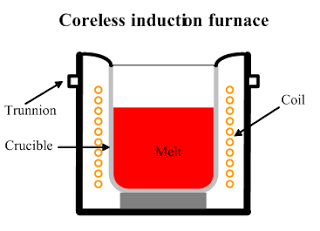Coreless Induction Furnace
As shown in Fig. 47.17, the three main parts of the
furnace are (i) primary coil (ii) a ceramic crucible containing charge which forms the secondary and (iii) the frame which includes supports
and tilting mechanism. The distinctive feature of this furnace is that it
contains no heavy iron core with the result that there is no continuous path
for the magnetic flux. The crucible and the coil are relatively light in
construction and can be conveniently tilted for pouring.
The charge is put into
the crucible and primary winding is connected to a high-frequency a.c. supply.
The flux produce by the primary sets up eddy-currents in the charge and heats
it up to the melting point. The charge need not be in the molten state at the
start as was required by core-type furnaces. The eddy- currents also set up
electromotive forces which produce stirring action which is essential for
obtaining uniforms quality of metal. Since flux density is low (due to the
absence of the magntic core) high frequency supply has to be used because
eddy-current loss We
∝ B2
f
2. However, this high
frequency increases the resistance of the primary winding due to skin effect,
thereby increasing primary Cu losses. Hence, the primary winding is not made of
Cu wire but consists of hollow Cu tubes which are cooled by water circulating
through them.
Since
magnetic coupling between the primary and secondary windings is low, the
furnace p.f.
lies between 0.1 and 0.3. Hence, static capacitors are invariably used in parallel with the furnace to improve its p.f.

Some of the advantages
of coreless induction furnaces are as follows :
They are fast in operation.
They produce most uniform
quality of product.
They can be operated
intermittenly.
Their operation is free
from smoke, dirt, dust and noises.
They can be used for all
industrial applications requiring heating and melting.
They have low erection and
operating costs.
Their charging and pouring
is simple.
Related Articles
Lesson meta keywords and meta description:
Write a public review